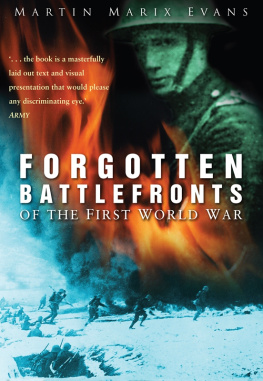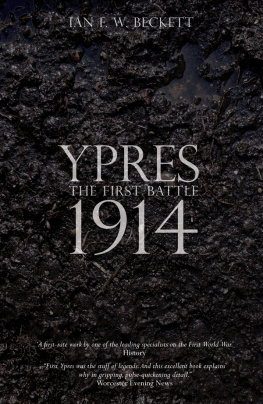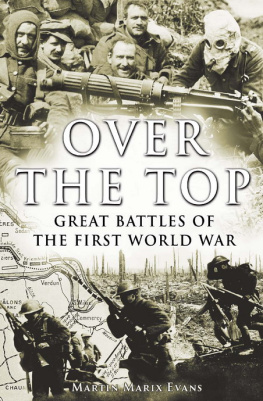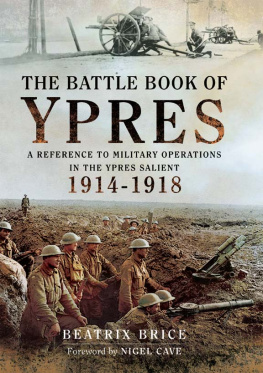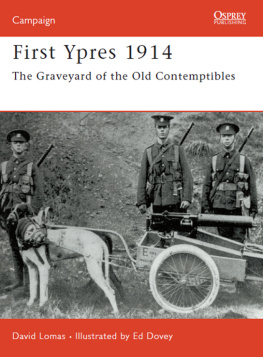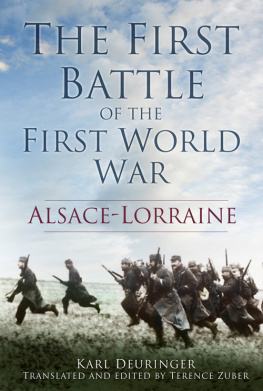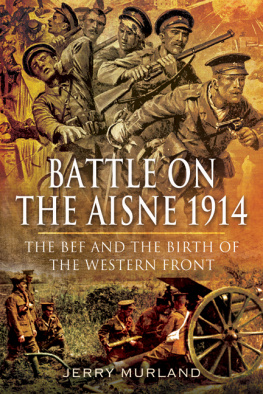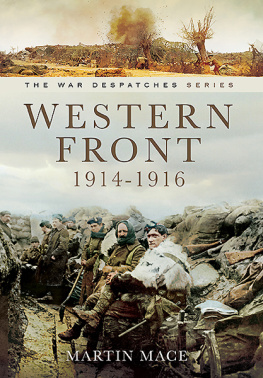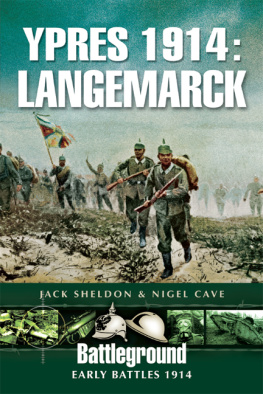FORGOTTEN
BATTLEFRONTS
OF THE FIRST WORLD WAR
FORGOTTEN
BATTLEFRONTS
OF THE FIRST WORLD WAR
MARTIN MARIX EVANS

First published in 2003
This edition first published in 2009
The History Press
The Mill, Brimscombe Port
Stroud, Gloucestershire, GL 5 2 QG
www.thehistorypress.co.uk
This ebook edition first published in 2013
All rights reserved
Martin Marix Evans, 2003, 2009, 2013
The right of Martin Marix Evans, to be identified as the Author of this work has been asserted in accordance with the Copyright, Designs and Patents Act 1988.
This ebook is copyright material and must not be copied, reproduced, transferred, distributed, leased, licensed or publicly performed or used in any way except as specifically permitted in writing by the publishers, as allowed under the terms and conditions under which it was purchased or as strictly permitted by applicable copyright law. Any unauthorised distribution or use of this text may be a direct infringement of the authors and publishers rights, and those responsible may be liable in law accordingly.
EPUB ISBN 978 0 7524 9995 6
Original typesetting by The History Press
C ONTENTS
INTRODUCTION AND ACKNOWLEDGEMENTS
My interest in the European fronts of the First World War other than the Ypres to St Mihiel frontage was stimulated by family connections and the chance offered by the discovery of a collection of unpublished letters and diaries. The family connection is my great-uncle Robert, who was born in Paris in 1895 and died there in 1970 having survived various unpleasant events in two wars. In the first of those he was in the Chasseurs Alpins. The discovery was of the papers of Guy Turrall by Ian Lyster who is, luckily, a friend of mine. The curiosity thus awakened led to the tracing of the career of a distant cousin, Reginald Marix, who first distinguished himself in the early days of the war in Belgium. Coverage of the Italian campaign then came naturally into the sequence.
The nature of the terrain over which these campaigns were conducted seems to me of central importance in seeking an understanding of how the war was fought. Given the very different kinds of source I have been able to use, the coverage of the four regions is inconsistent, but I can see no reason to exclude an excellent trench map from one section only because I have no similar map for another or skimp on good photographs where they are numerous merely to preserve a notion of equality. Similarly, original, previously unpublished accounts are quoted in the Salonika section while previously published, though perhaps somewhat obscure, sources are used elsewhere. To this unevenness I trust the reader will be willing to extend indulgence. The spelling of placenames has altered a great deal since the early twentieth century. I have reproduced quotations exactly as written and tried to use the contemporary British version when in doubt.
More substantial details of the sources are given in the listing at the end of the book. I am particularly grateful to Ian Lyster and his brother for permission to make use of their fathers memoir and to Ian for access to Guy Turralls papers, maps and photographs. For permission to quote from these I am indebted to Dr Ann Turrall. Cleone Woods has kindly given permission for Geoffrey Malins to be quoted. I am also grateful for permission to quote from published sources but, at the time of going to press, the status and ownership of copyright in some of the material remains uncertain and I would be grateful for information to enable me to resolve these matters.
The modern, colour photographs are intended to convey the nature of the terrain and to tempt people to visit the battlefields. I am fortunate to have had help from a number of people who have guided my research, provided information or given permission to use their pictures. Robert Gils of Simon Stevinstichting was generous in his provision of plans and data, more than I could find room for, and with his introductions to the photographers J.-P. Lacroix, Rudy van Nunen and Bart van Bulck who have allowed me to reproduce their work. Alex Deseyne of the Raversijde Museum, Ostend, undertook a photographic tour expressly to make good my deficiencies in illustration and also provided essential information. Guy Cavallaro, whose eagerly awaited new work on the war in Italy is at press at the time of this writing, has lent both modern and contemporary photographs. The British campaign in Salonika is the subject of a substantial and important study, as yet unpublished, by Alan Wakefield, Simon Moody and Andrew Whitmarsh. They have kindly allowed me to reproduce photographs taken recently on their research trips to the region, generously putting aside what must have been an inclination to reserve them for their own, exclusive use. I am grateful to Philippa Carling for allowing me to use photographs she has taken in difficult terrain in the Dolomites and to John Chester for his pictures of the Trentino sector.
Private archive illustrations have come from the Turrall collection, Brian Kibby and the family album kept by my father, Jean-Paul. I am grateful to the administrators of the public archives at the Imperial War Museum, London, the In Flanders Fields Museum, Ypres, the Provinciale Biblioteek en Cultuurarchief, St Andries, and the United States Army Military History Institute, Carlisle, PA, for their contributions to this work. The captions to the illustrations include credits as appropriate. Unattributed pictures are either from my own collection or were taken by me. I have had the advantage of access to Leo Coopers extensive library and enjoyed the benefit of his advice. It was he who first sparked my interest in the First World War and I am deeply indebted to him. The patience my wife, Gillian, has summoned up to read and correct the text, not to mention soothing the fevered brow and carting spare cameras across mountains, has been heroic.
Martin F. Marix Evans
Blakesley, 2003
T HE
B ELGIAN F RONTS
All day long stretcher-bearers were picking up the dead and wounded, while we continued to fire from time to time. All the wounded we have picked up are young men, sixteen to twenty years old, of the last levy.
Observations of a French Marine based at Dixmude, October 1914
O NE
I NVASION AND S IEGE
On Sunday 4 August 1914 Germany invaded Belgium. The possibility had long been foreseen, but other options had been given equal weight. The Belgians were so eager to preserve the purity of their neutrality that they were ready to contemplate each of their neighbouring countries as prospective invaders, for while the threat of a German incursion was likely enough, might not France strike against Germany and violate Belgian sovereignty, or Britain land at Antwerp to do the same? The result was that Belgium enjoyed a supportive military relationship with no one and was obliged to fend for herself.
The defence of the country rested on the existence of three strong fortified areas, Lige and Namur on the River Meuse in the east and south respectively and Antwerp in the north-west. The cities were surrounded with rings of forts, massive, subterranean structures now some forty years old. The river-based complexes could be by-passed if not supported by armies in the field alongside them and the North Sea link to Antwerp depended on passing through the territorial waters of the Netherlands, also a country fixed on remaining neutral in which case belligerents were barred from the Scheldt. As late as 1913 steps had been taken to increase the size of the army. The conscription level of 1909 was raised with a view to creating a field army of 180,000 men and having 200,000 older troops for the garrisons of the forts while the rest of the adult males would serve in the Garde Civique. This new programme was designed to reach its full effectiveness in 1926. The effort to expand the army to meet the crisis of the summer of 1914 magnified the problems of poor training and shortage of qualified officers that dogged the Belgian forces when war came upon them. At the start of August the commander-in-chief, King Albert of the Belgians, had a Field Army of 117,000 men, 324 guns, 108 machine-guns and 12 aircraft.
Next page
